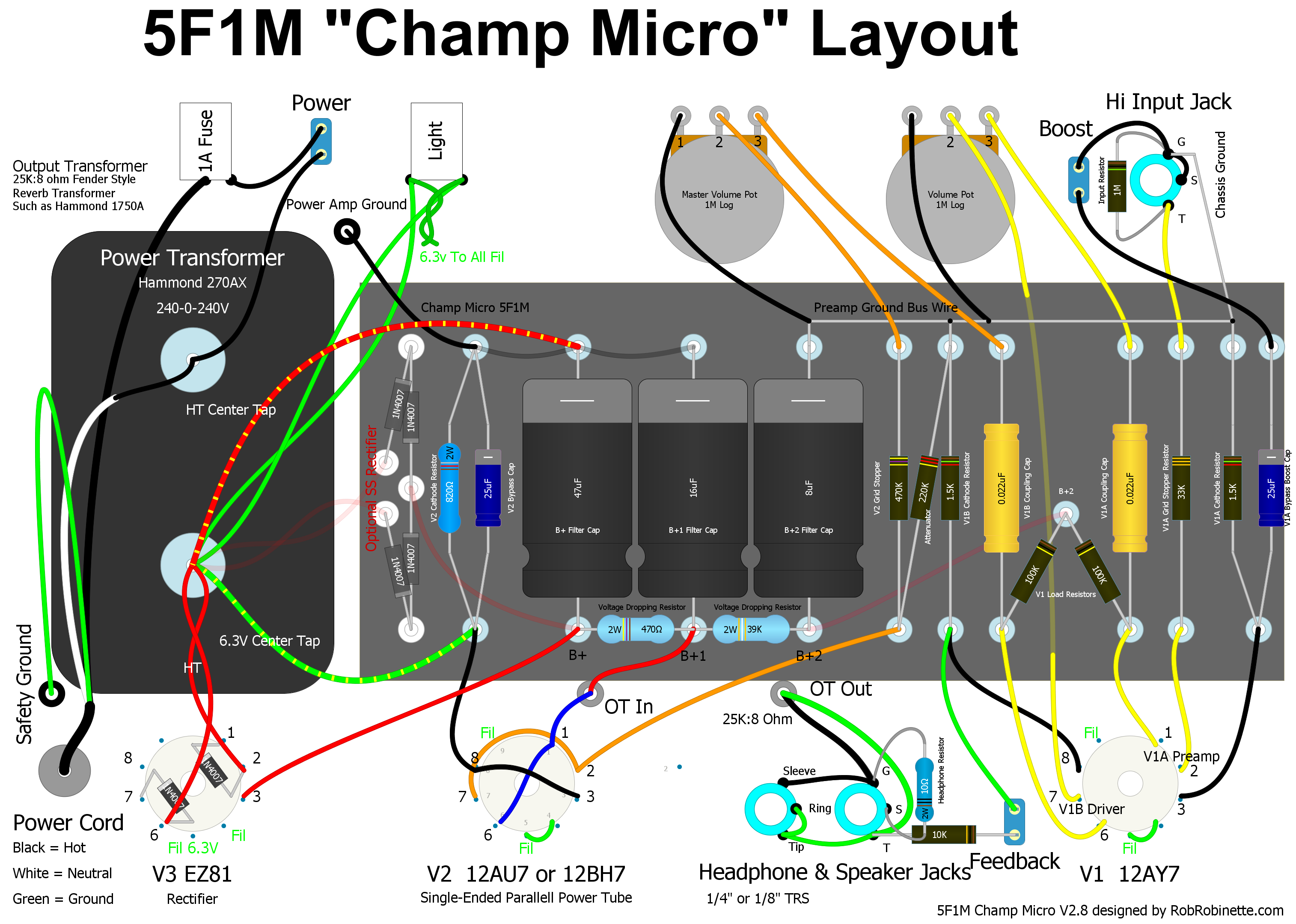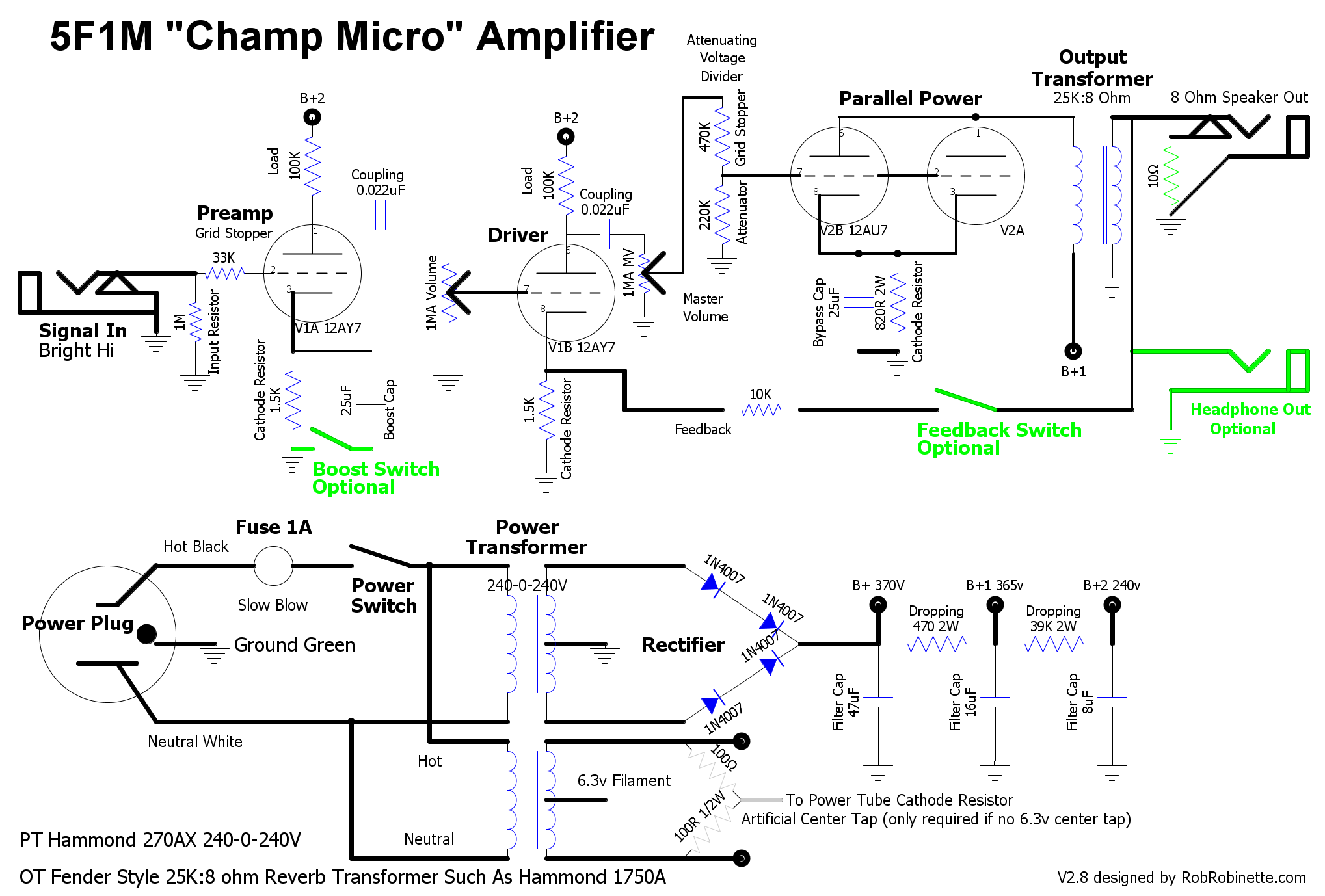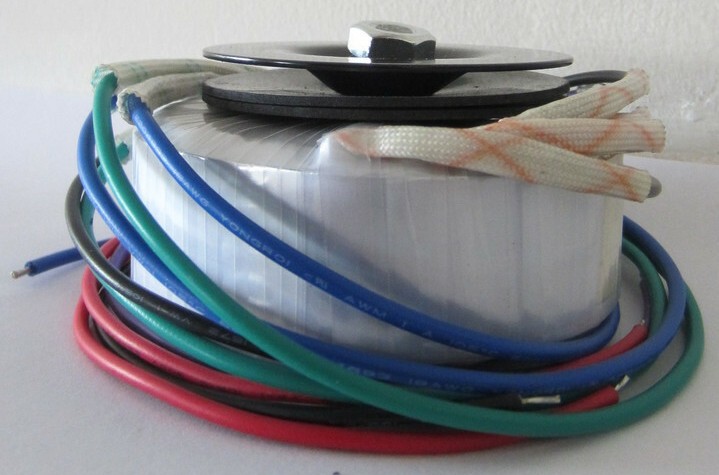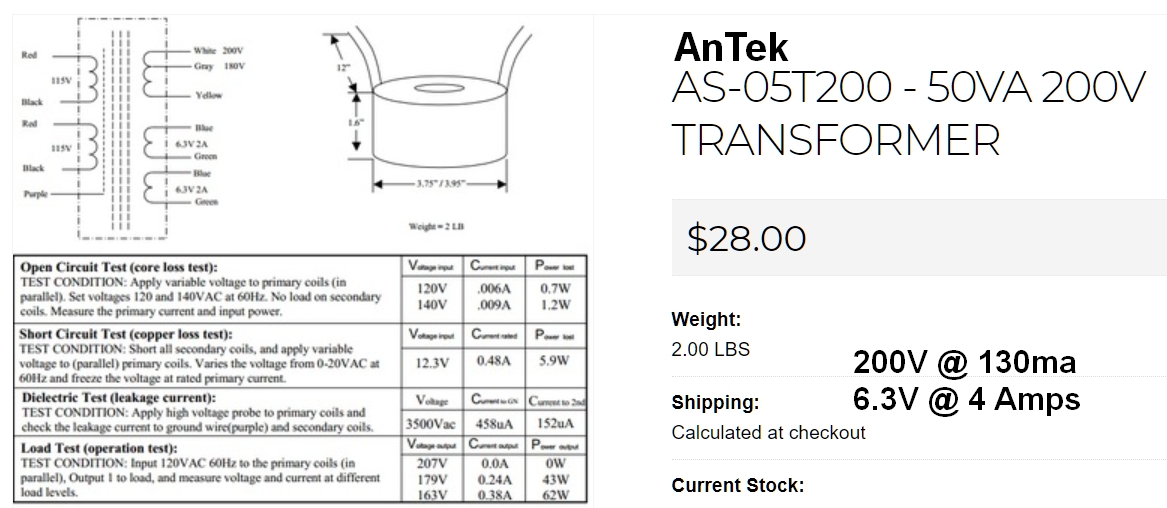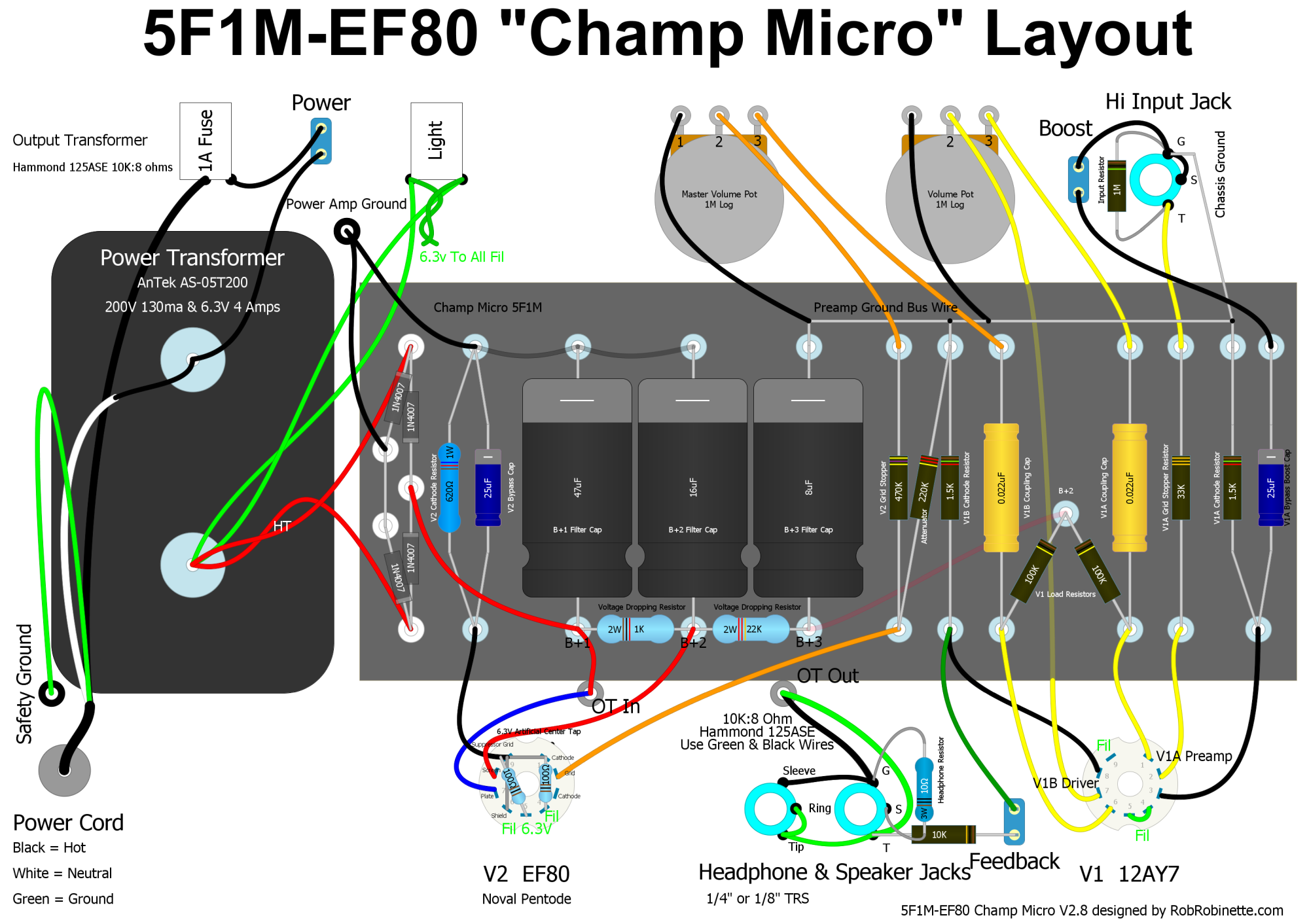5F1M Champ Micro© Guitar Amplifier
By Rob Robinette
Update May 2022: Changed power tube attenuator resistor from 56k to 220k to increase gain and output volume.
Update Mar 2021: The best demo video yet:
Update Dec 2020: I added an EF80 small pentode power tube version of the Champ Micro
Update Jan 2019: Here's another excellent demo video of the Champ Micro and the varying tones available:
Update May 2017: Here's an excellent demo:
After the Deluxe Micro turned out so well I thought I'd fill out the Tweed Micro amp series with a Micro version of the simple but great sounding late 1950's Fender tweed 5F1 Champ. The full size Champ puts out 5 watts of power and as many people have figured out, that's too much for apartment dwellers or basement practitioners. The Champ Micro tube guitar amplifier is compact practice amp that's very easy to build, uses two 12A*7 tubes and puts out 0.75 watts of clean output power which drives a Weber 12A125A 12" Alnico speaker very well. The Champ Micro's single channel preamp circuit was inspired by the 5F1 Champ's Hi channel. The Champ Micro features two stages of gain and a dual triode parallel single-ended 12AU7 power tube from the proven Deluxe Micro.
WARNING
The Champ Micro project utilizes full size amp, POTENTIALLY FATAL HIGH VOLTAGES. If you are unfamiliar with high voltage circuits or are uncomfortable working around high voltages, DO NOT RISK YOUR LIFE BY BUILDING THEM. Seek help from a competent technician before building any unfamiliar electronics circuit. RobRobinette.com DISCLAIMS ALL LIABILITY FOR INJURY OR PROPERTY DAMAGE RESULTING FROM THIS INFORMATION. ALL INFORMATION IS PROVIDED 'AS-IS' AND WITHOUT WARRANTY OF ANY KIND. See more tube amplifier safety info here.
Eyelet or Turret Board Layout
Note an optional diode rectifier is shown (left edge of circuit board) along with an EZ81 tube rectifier--choose one rectifier. Click the image to download a hi-res PDF layout file. You can download the DIY Layout Creator file of the layout here.
Shown with simple four diode rectifier. Click on the image to see a hi-res pdf of the schematic (this is true of all the layout diagrams on this webpage). You can download the DIY Layout Creator file of the schematic here.
Dan Miller's Champ Micro #2
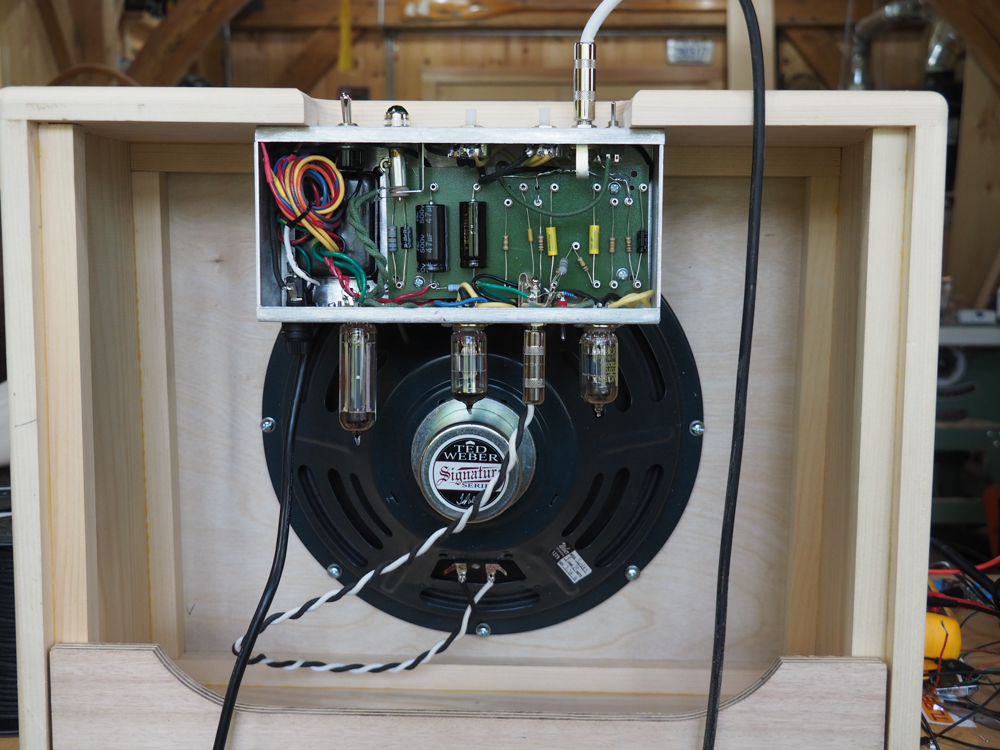
Dan used an EZ81 for tube rectification (large tube at far left).
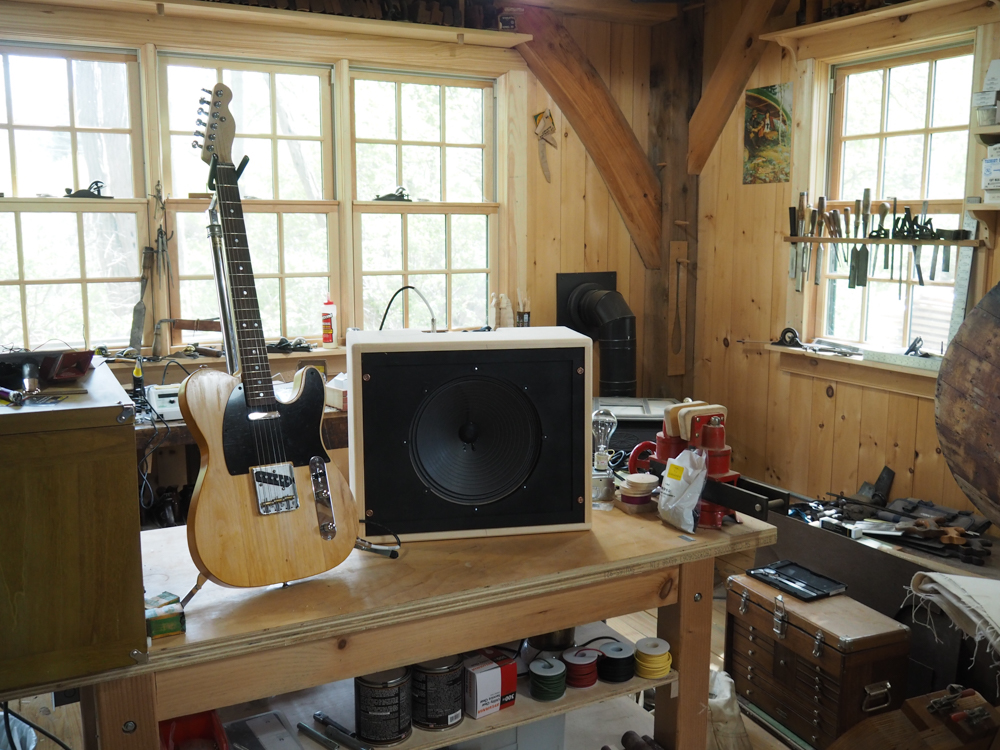
David's Champ Micro #1
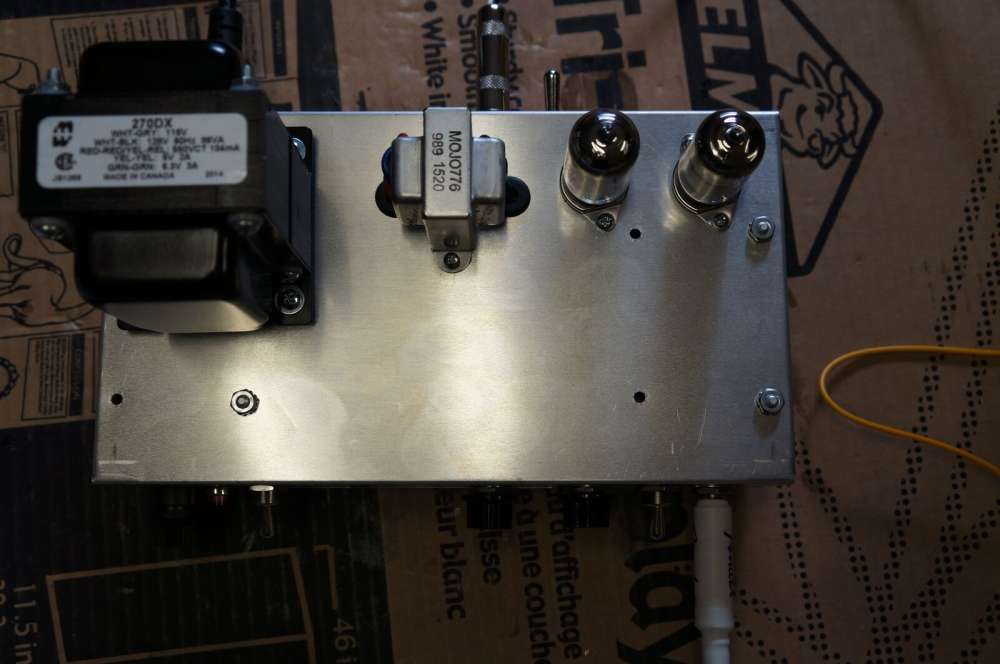
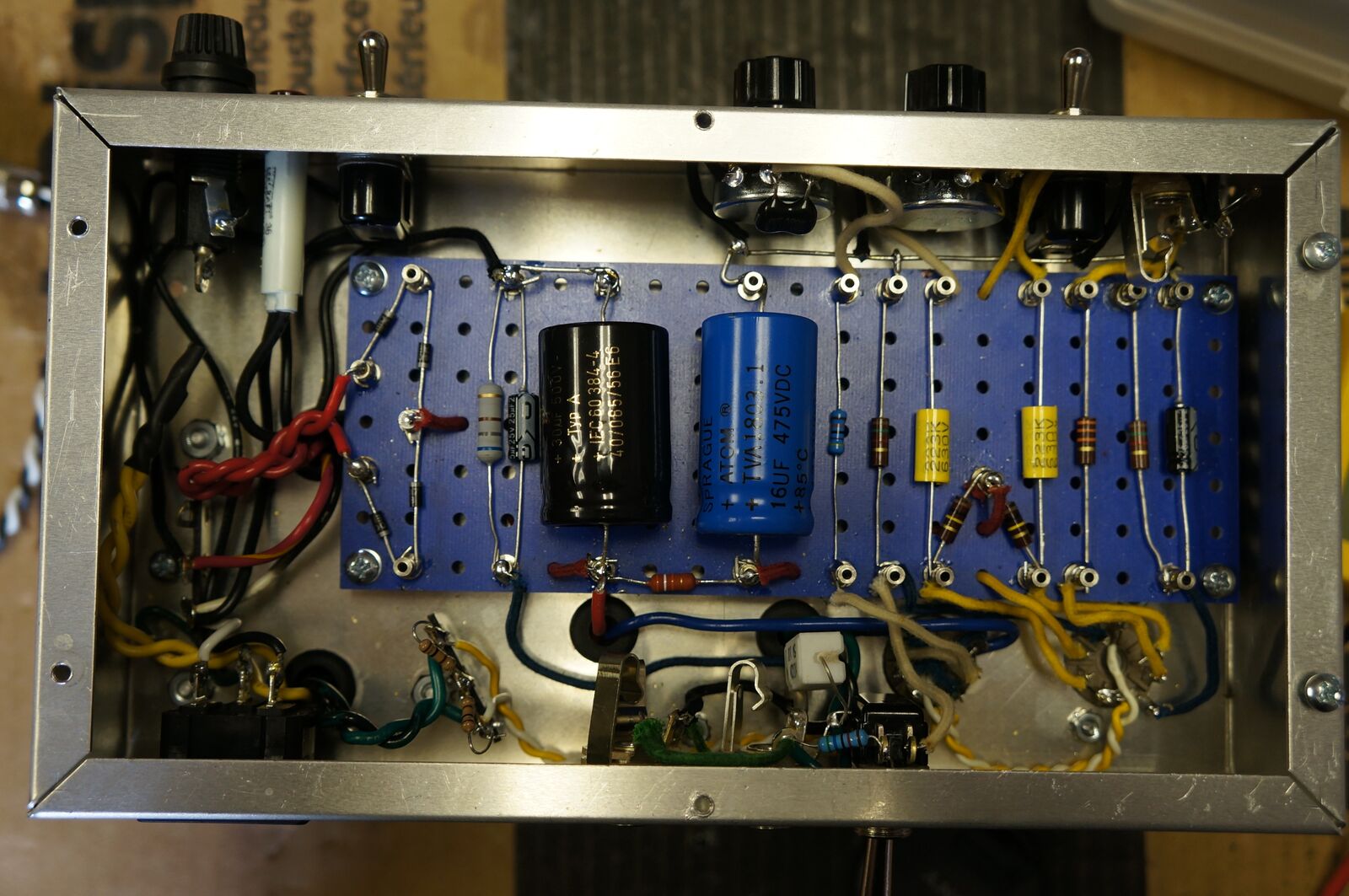
David's Champ Micro uses solid state rectification (4 diodes at left end of blue circuit board) so only two tubes were required.
Andre's Champ Micro
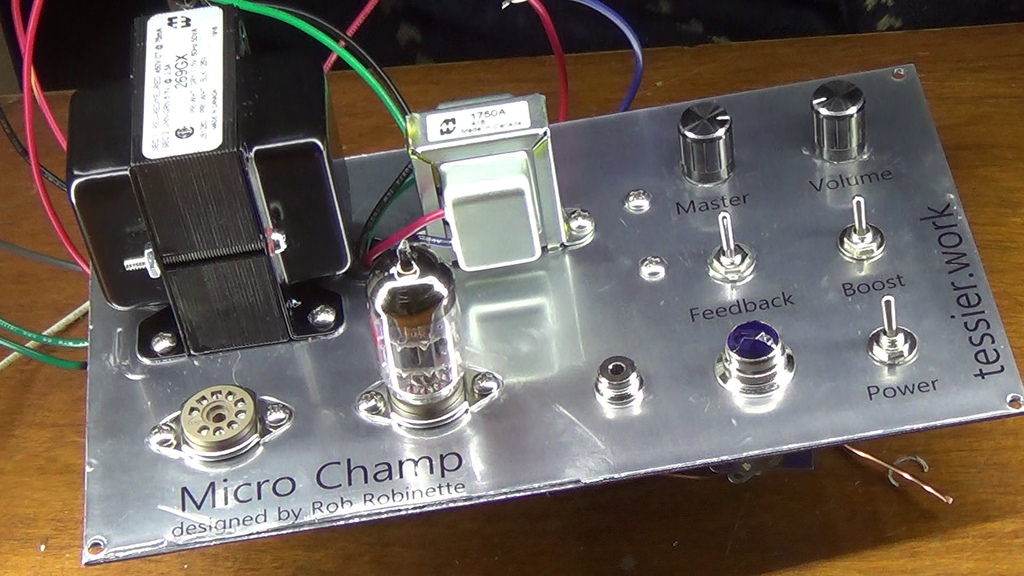
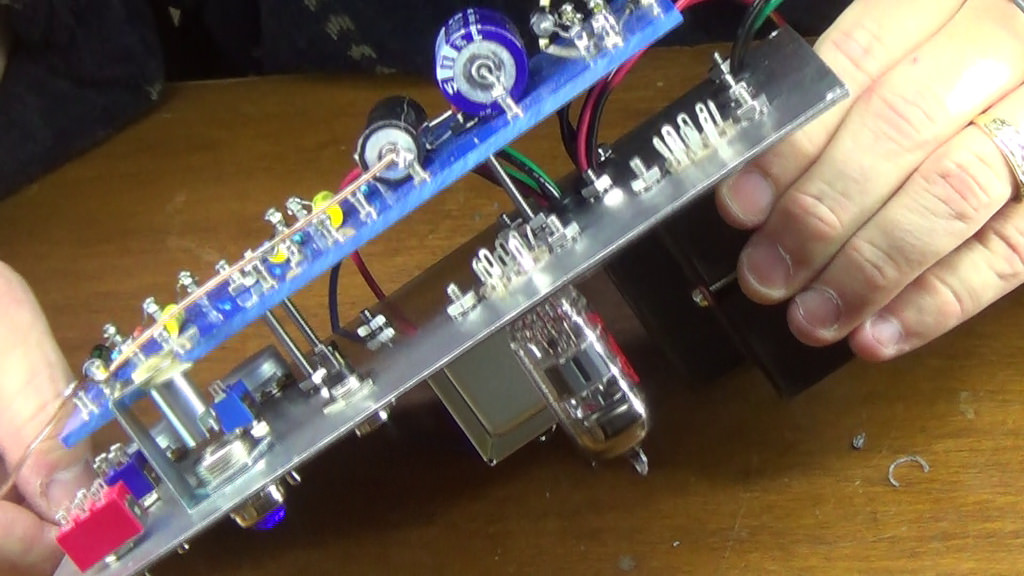
Design
I'm a big fan of the 1950's Fender tweed amps and the 5F1 Champ is a simple but great sounding tube amp so I decided to design a Micro version of the Champ. I used an almost exact copy of the Champ's Hi preamp channel and paired it with the Deluxe Micro's 12AU7 based parallel twin triode single-ended power amp.
The optional Negative Feedback Switch allows you to disconnect the feedback loop and get a grittier, more 5E3 Deluxe type tone with earlier breakup, or turn on the feedback for the standard Champ tone. I went with a 10k feedback resistor after tuning by ear.
The EZ81 rectifier tube uses a standard 9-pin socket and 6.3V filament heat so no 5V power transformer output is needed. If your power transformer does have 5V available and you'd rather use a standard, full size 8 pin rectifier tube like a 5Y3GT then just wire the 8 pin socket with the HT to pins 4 and 6, 5V heater lines to 2 and 8 and the B+ power line to pin 8. The layout diagram also shows an optional 4 diode rectifier that would replace the tube rectifier.
Development
My recommended power transformer is the Hammond 270AX 240-0-240V for 120V mains (USA) and I recommend the Hammond 369HX for international builders which is 225-0-225V HT
Using my Firefly's Hammond 269EX 190-0-190v power transformer I only got a B+1 of 285V and the V1 plates were at 110V which is a little low. The Deluxe Micro sounded good but not as good as with a B+1 closer to 400V. If you do use the Hammond 269EX 190-0-190V $47 power transformer, I recommend you reduce the B+2 27K ohm 2 watt voltage dropping resistor to 22K to keep the V1 preamp tube's plate voltage up near optimum.
The output transformer is a Fender style reverb transforme rated at 25K:8 ohms and 3.5 watts such as the Hammond 1750A. The Classictone 40-18034 will also work.
The 12AY7 and 12AU7 use 0.3 amps of 6.3v heater current. If you use an EZ81 rectifier tube it uses about 1 amp of heater current so any power transformer that supplies 2 amps of 6.3v for tube rectification will work, or 1 amp of 6.3v if you use diode rectification.
A simple four diode rectifier can be used in place of the EZ81 rectifier tube to simplify construction and since the Champ Micro is a Class A amp it won't generate voltage sag using a tube rectifier so there should be no tone difference between tube and solid state rectification. If you use a power transformer without a HT (high voltage) center tap you will need to use a four diode bridge rectifier instead of the diode rectifier shown in the schematics and layout diagrams below.
The optional Headphone Jack can be full a size 1/4" or the now more common 1/8". The nice thing about a 1/8" jack is you won't mistake it for the Speaker Jack. The Speaker Jack has a 10 ohm 2 watt Headphone Resistor across it to load the output transformer with an 8 ohm load when headphones from 32 to 600 ohms of impedance are used. The 10 ohm resistor is automatically disconnected when a speaker is connected. Be careful with the volume control when using headphones. Make sure it is at minimum volume when the amp is powered up and turn the volume knob slowly to keep from blowing out your headphones and ears. The Headphone Resistor gives the additional benefit of loading the output transformer with a 10 ohm load to prevent damage if you forget to plug in a speaker. If you don't want the headphone jack simply delete the jack and replace the 10 ohm headphone resistor with a jumper wire.
Test and Tweak On the Prototype Bench
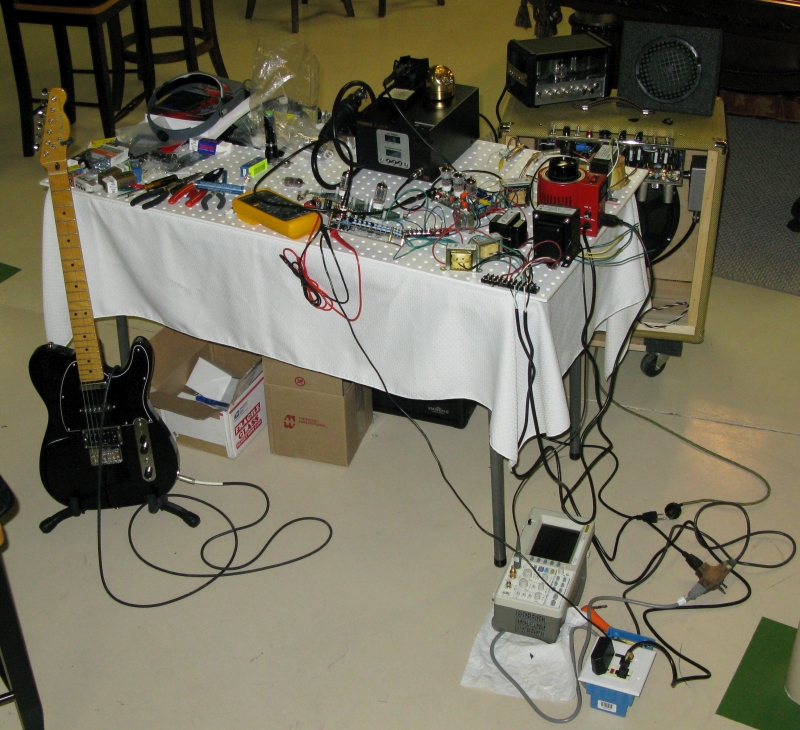
Red variac controls just the HT AC voltage to the amp. Separate 6.3V transformer supplies heater current. During the test and tweak phase of development I will compare the Champ Micro to my 5E3P Deluxe (top right in tweed cabinet), my Deluxe Micro, a Firefly micro amp (just left of the red variac) and an H&K Tubemeister 5 (on top of the Deluxe). I play them all through a Weber 12A125A 12" Alnico speaker in an open back extension cab (behind table), a 15" JBL E130 with hemp cone (in the 5E3P cab) and an Eminence 620H hemp coned 6" speaker in a small enclosure (on top of the Deluxe). The blue box at bottom right next to the oscilloscope is a bucking transformer used to lower the heater voltage to spec.
I added a Master Volume to the power amp because it's needed to control how hard the little 12AU7 power tube is driven. The Master Volume also does a good job of controlling the output for true bedroom amp volume levels. The Master Volume is also very helpful when pedals are used with the amp because you can keep from overwhelming the little power tube when using high output FX. I added a 100pF Master Volume Bright Cap to add some brightness at lower master volume levels. At max Master Volume setting the Master Volume has no impact on the circuit--it's as if the Master Volume is not there.
You need to play with the Master Volume to get the most out of this amp and to control the balance of preamp and power tube distortion. The Volume pot controls the preamp tube and the Master Volume controls the power tube. Some high output guitar pickups and effects pedals can push the power tube too hard and cause some funky power tube distortion. If this occurs just dial back the Master Volume a little.
I have an Electro-Harmonix 12AY7 in V1, JJ 12AX7 in V2. I've heard great things about the long plate JJECC802S 12AU7 as a power tube so give it some consideration. I typically set the tone control to about 9 and leave it alone and then play with the amp's two volume controls--don't set the Master Volume and forget it, it has a lot of affect on the amp's tone. When you want to really turn up the overdrive try a 12AX7 in V1. The Champ Micro handles a 12AX7 in V1 well because the Master Volume can keep the little power tube from being overdriven into oblivion. I'm really surprised all micro amps don't have a Master Volume, it really is necessary to make a small amp versatile.
I will play the Champ Micro through three different speakers during testing: My favorite Fender tweed era speaker is the Weber 12A125A 12 inch Alnico in an open back cab. The little Champ Micro sounded best with this pairing--very rich and tweedy and it made my Telecaster sound like a Tele should. The 12A125A is a low efficiency speaker rated at 97dB but the Champ Micro still put out plenty of volume at high Master Volume settings.
I also tried my favorite small speaker, an Eminence 620H 6 inch hemp coned speaker. If you need lower volume this little speaker is the way to go. It still sounds very good with less of everything compared to the Weber but max volume is quite a bit lower.
Finally I hooked up my 5E3P Proluxe's 15 inch JBL E130 hemp coned speaker to the Micro. It's a very high efficiency (105 dB) driver that pumps out loud, clear, accurate guitar tone. The Champ Micro was crazy loud and sounded fantastic. I really had fun with this speaker for high distortion shredding with a 12AX7 in V1 but it was loud enough that my wife had to intervene. I recommend you go with an 8" or larger speaker because this amp sounds too good to be strangled by a 6" speaker. Bottom line is any speaker that works with a full size tweed amp like the Deluxe should work well with the Champ Micro.
I compared the Champ Micro's tone to my Firefly micro amp (single self-split push-pull 12AY7 power tube) and H&K Tubemeister 5 (push-pull 12BH7 power tube). The biggest difference in tone is the Champ Micro's 5F1 low end. It's always there no matter how hard you shred the little amp, while the Firefly and Tubemeister scream with modern high pitched accuracy. You could really hear the difference between the two amps through the big 15" JBL but the Champ Micro blows away the other amps when playing clean through the Weber 12A125A 12" alnico.
For the most authentic 5F1 Champ tone I highly recommend Weber Alnico speakers. Their Vintage and Signature Alnico speakers drip authentic Fender tweed tone. They offer two lines in sizes from 6 to 15 inches. I personally love my Weber Vintage 12A125A 30 watt (12" Alnico, 1.25" voice coil $104) but people really like the Signature line that runs at about half that price and $55 is crazy low for a nice 12" Alnico speaker. The $999 Fender Eric Clapton Vibro Champ comes with an 8 inch Weber Signature Alnico. Keep in mind all these speakers need a break in period and will sound better after being worked in. Weber offers a break in service so they will sound perfect right out of the box.
For ultimate convenience building a small combo amp paired with an 8 inch Weber Vintage 8A150 speaker is probably the way to go but be sure and try the Champ Micro with other speakers so you can really appreciate how good it sounds with a real, full sized tweed speaker.
If you like to mod your amps many of my 5E3 modifications apply to the Champ Micro. If you decide to add tube reverb I recommend you tap the signal at the volume pot input.
Three Terminal Tag Strip
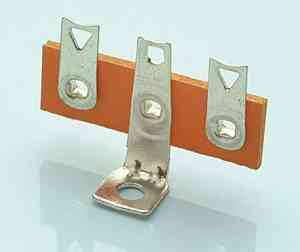
These tag strips are great for point-to-point wiring. Keep in mind the middle terminal will be grounded to the chassis unless you isolate the strip from the chassis and bolt. If you plan to use the middle terminal as a ground be sure and clean the chassis around the bolt and use a star washer between the chassis and tag strip for a good chassis ground connection.
Building the Champ Micro
I get most of my parts from tubeamplifierparts.com and Mouser.com. TubeAmplifierParts.com for everything I can get from them and then Mouser for everything else.
This 5F1 Champ chassis designed for EL84 (9 pin power tube) will work great for the Champ or Deluxe Micro.
Bill of Materials
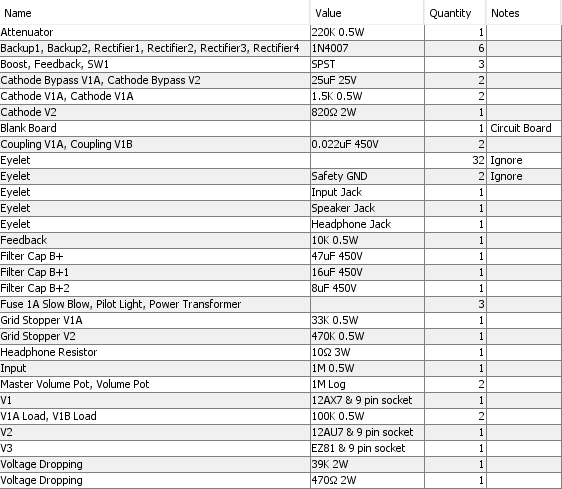
You will also need power and output transformers, a speaker, cab and power cord.
This is the general build sequence I recommend:
Start with the circuit board, either eyelet, turret, B9A development board or even perfboard. The circuit board should be at least 6" x 3" by 1/8" thick. Use #3 Eyelets or Turrets for 1/8" (0.125") thick board.
I like to measure and record the resistance value for all the resistors as I put them on the circuit board. Knowing the exact resistance value can come in handy when measuring bias and troubleshooting and it can keep you from putting a 470 ohm resistor where a 470K is called for.
Install the rest of the components to populate the board but don't start soldering until they are all in place and you're sure they are placed correctly. Make sure the negative terminals of the big electrolytic filter capacitors are connected to ground because they may explode and damage the output transformer if installed backwards. Most filter caps have an 'indention' on their positive end and arrows pointing to the negative end. Remember to leave the turret top holes available for leads that run from the turret to the tubes, controls and jacks. I use the '3/4 lead wrap around the turret' method which is old mil spec. Install tube, jack and control wires and leave a couple inches of extra wire so you can trim to fit later.
22 gauge wire is fine for all the amp's wiring including the heater wires. I recommend you connect the 6.3V filament heater wires from the power transformer directly to the rectifier diodes or tube, then split two wires from there: a set of wires to the pilot light and one to V2 then on to V1. For wire color I like to use yellow for the signal path, red for power, black for ground and green for heaters. This is a good time to post a pic of the board (front and back) on a guitar forum for others to review. I like the TDPRI Shock Brothers DIY Amps forum (I'm robrob). Be sure and keep a photo of the back side of the board so you can review it in case you have to troubleshoot the amp at startup--you don't want to have to remove the circuit board to verify its backside wiring and solder joints.
You need a good quality soldering iron with a clean, pre-tinned tip to successfully solder eyelets and turrets. Frequent tip steam cleanings using a damp sponge will keep your solder joints looking good. When soldering eyelets I like to use a little flux paste on the eyelet and the component leads because it really helps the solder adhere for a good, long term connection. I just dab a little on the joint using a thin artist paint brush. Chasing a cold solder joint can be a colossal pain in the butt.
When soldering turrets keep in mind they are pretty good heat sinks so you need to apply soldering iron heat to the turret for a few seconds before making contact with the component leads. This will keep you from frying components as you wait for the turret to get hot enough to bond with the solder. Speaking of frying components, it's a good idea to use a heat sink clamp on component leads--especially capacitor leads--to protect the component. Even just an alligator clip on the component lead between the soldering iron and component body will protect it from over heating.
A Champ or Deluxe chassis will work to fit the 6" x 3" circuit board. You may need some octal-to-noval (8-pin to 9-pin) hole adapters so you can fit 1 or 2 tubes where the 6V6 power tube would go. You will have some extra input jack holes. You can use these holes to mount switches for mods like switched negative feedback and a bright switch. You can always use a normal, 8 pin sized 5Y3GT as the rectifier tube since that size hole is already available. This is probably the easiest way to go because there are so many 5F1 combo cabs and head cabinets available. You can also go with a 'table top' style chassis that could easily be installed in a small cab. Hammond sells an aluminum 1444-16 10" x 6" x 2" blank chassis that will be roomy but you will have to drill your own tube holes using a step drill bit.
Mount the tube sockets, pots, fuse, power switch, pilot light and transformers in the chassis and do as much wiring on these as you can before you mount the circuit board because it will get crowded in the chassis. Don't forget to do the heater wires first, before you install the circuit board and begin hooking up the other tube leads. Try to keep the tightly twisted heater wires down against the chassis floor to reduce noise and hum.
Install the circuit board and connect all the leads. Post detailed pics for forum review before applying power. I recommend you follow my Amp Startup Procedure. Following it can prevent damage from a mis-wired amp. If you have a light bulb current limiter you should use it for the startup.
Champ Micro EF80 Small Pentode
This EF80 version of the Champ Micro uses a small noval pentode to more closely capture the tone of the full size single ended 6V6 octal pentode 5F1 Champ. The EF80 tube uses a normal 9-pin socket and 6.3v heater filaments. The Champ Micro's B+ filter node is now used for the power tube plates (B+1). The first voltage dropping resistor has been increased to 1k and B+2 now powers the power tube screen grid. The second voltage dropping resistor was decreased to 22k to keep B+3 voltage relatively unchanged. Output power will be around 1 watt.
My recommended power transformer is the $28 AnTek AS-05T200 toroidal power transformer 200v @ 130ma (50VA), 6.3v @ 4 amps. It must be used with a bridge rectifier. You can build the bridge rectifier with four 1N4007 diodes or get an inexpensive bridge rectifier like this $1 three amp 1000v bridge rectifier from Mouser. The AS-05T200 has a 120v and 240v primary (240 primary is good for 220 to 250v mains). It also has a 180v HV tap in case you want to lower the amp voltages (use gray and yellow wires for 180v). Another bonus is it only weighs 2 lbs. Size is 3.75" in diameter and 1.6" tall. You can mount the transformer on the top of the chassis and purchase a 105x45mm round transformer cover, leave it exposed or mount it inside the chassis. Two 3-terminal tag strips can be used to anchor four 1N4007 diodes to make the bridge rectifier.
Detailed AnTek Wiring
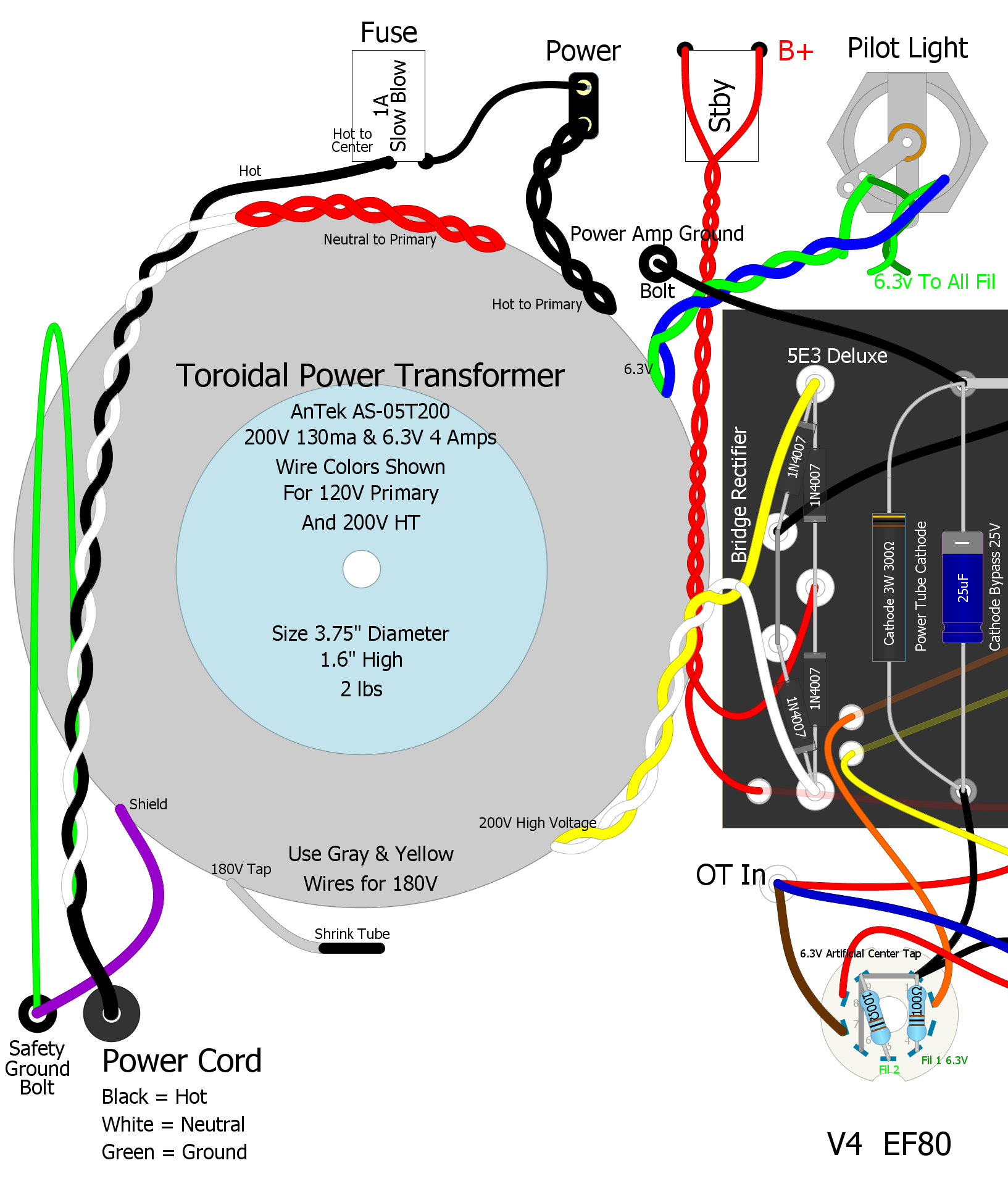
AnTek toroidal power transformer and bridge rectifier wiring detail.
If you would prefer to use a "normal" (non-toroid) power transformer then I suggest the $89 Hammond 269EX 190-0-190V power transformer with 190-0-190 high voltage at 75ma, 2.5 amps of 6.3v heater current. For international builders I recommend the Hammond 369EX which has 100, 110, 120, 200, 220,230, 240 VAC 50/60 Hz primaries. The 269EX/369EX is a good choice for any amp using an EF80 power amp but it does not include a 5v secondary so if you want to use a tube rectifier use an EZ81 (6.3v).
At 270 to 300v on the plates and a 620 ohm cathode resistor (as in the layout below) you can expect about 5.2v across the cathode resistor with the EF80 runnigh at 2.45 watts, 95% plate dissipation with 8.4 milliamps of plate current. Adding a 1k 1/2 watt screen resistor will add some screen sag distortion and emphasize the difference between triode and pentode overdrive.
Hammond 269EX/369EX Power Transformer
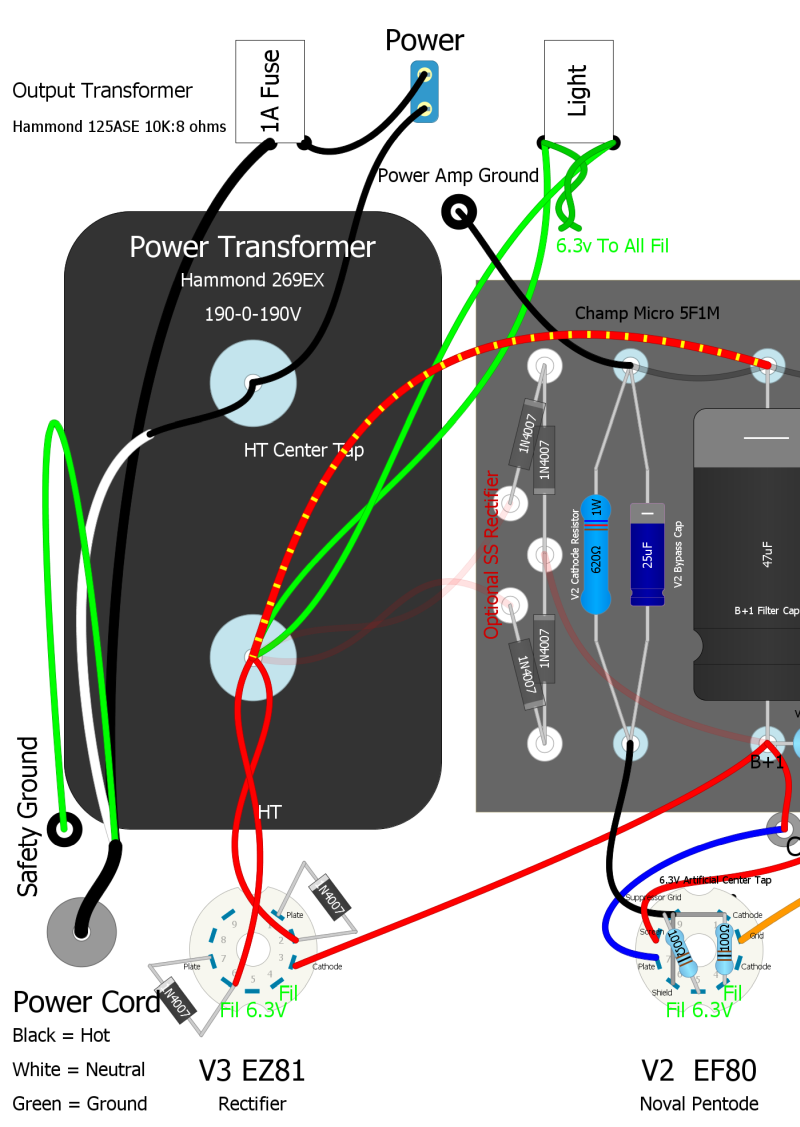
"Normal" power transformer with high voltage center tap and EZ81 tube rectifier. Note the optional conventional full wave solid state rectifier shown at center and the position of the high voltage center tap.
The Champ Micro EF80 uses a Hammond 269EX (USA) or Hammond 369EX (International) power transformer and 125ASE 3 watt output transformer wired for 10K:8 ohms using the green and black wires. The cathode resistor has been changed to a 620 ohm 1 watt to better suit the EF80 power tube. It uses the same circuit board and Hoffman board file as the Champ Micro. Click the image to see the hi-res version. Download the pdf.
Doug Hoffman at HoffmanAmps.com can make you a Champ Micro EF80 turret or eyelet board using this Hoffman board file for about $20 + shipping. Just go to the HoffmanAmps DIYLC Analyzer page and upload the Champ Micro Hoffman board file
EF80 Pinout
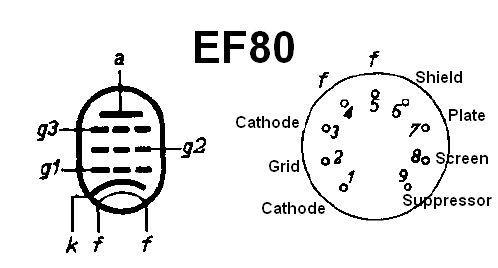
The EF80 pinout is: 1. Cathode 2. Control Grid g1 3. Cathode (same as 1) 4. Heater 5. Heater 6. No Connection (can be used as component anchor) 7. Plate or Anode 8. Screen Grid g2 9. Suppressor Grid g3.
Bill of Materials
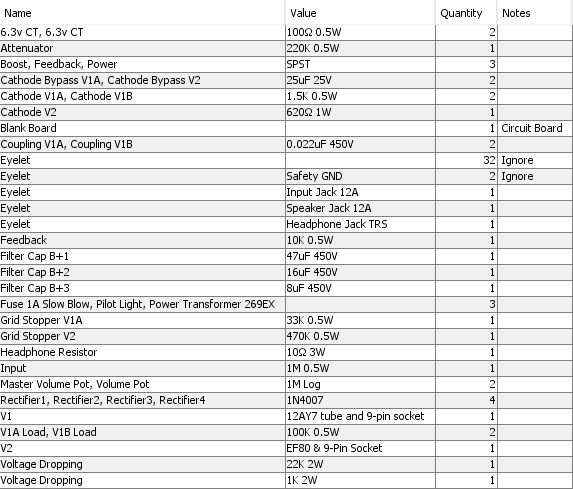
You will also need an output transformer, chassis, cab, speaker and power cord.
Champ Micro EF80 Plate Characteristics Chart
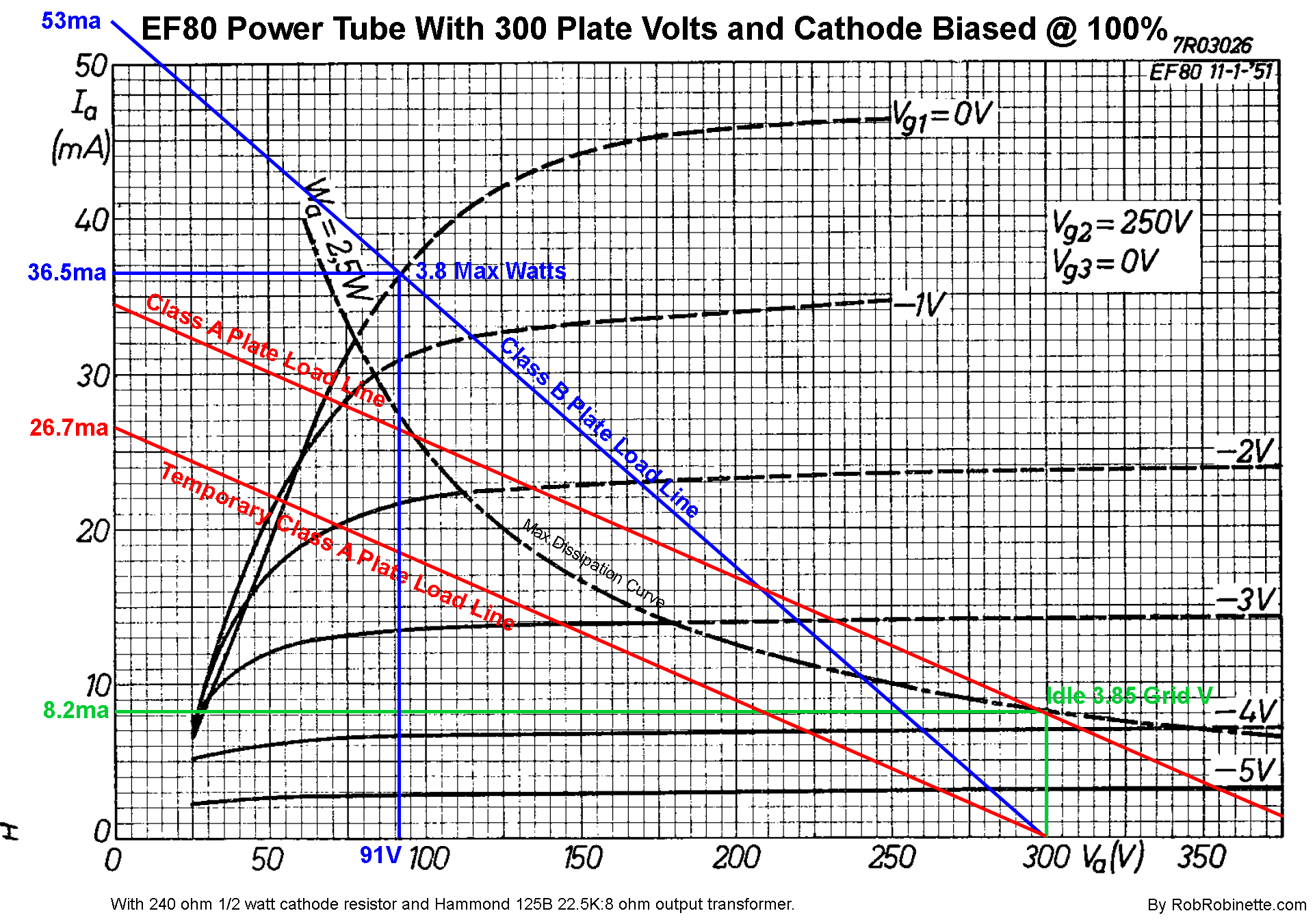
The green idle lines show the idle bias, quiescent or Q point. The Champ Micro EF80 will idle at 300 plate volts, 8.2ma of plate current, 3.85 grid volts, 2.5 watts and 100% of max plate dissipation. The lower red line is the temporary Class A plate load line which runs from 300 volts to 26.7ma. We slide the line up to meet the idle bias point so the upper red line is the actual Class A plate load line. The blue line is the Class B plate load line which runs from 300 volts to 53ma. The point where the blue Class B line intersects the 0 grid volt curve gives us maximum output power.
Brighten the Champ Micro for Humbucker Guitars
Humbucker pickups pass a lot of low frequency energy to an amplifier so they tend to sound darker than single pickup guitars. The easiest mod to make a tweed amp work better with humbuckers is to reduce the size of the V1 cathode bypass cap from 25uF down to 1uF (25v or higher). This will trim some of the excess bass from the humbucker pickups which will brighten the tone. If your single pickup guitars sound too bright after the mod just roll off some highs using the guitar or the amp's tone control.
Champ Micro Double Boost Mod
This is a simple mod that adds a .68uF 25v (or higher voltage) cathode bypass capacitor to V1B (driver stage) to significantly boost preamp gain and increase distortion in V1B and the power tube. Turn the Negative Feedback switch off for the biggest V1B boost and hairiest tone.
You can try this mod by simply alligator clipping the .68uF cap across the V1B 1.5k cathode resistor to see if you like the tone. If you do this be sure and try it with and without the V1A bypass cap engaged.
There are three ways to do this mod. You can simply tie the new V1B bypass cap's ground to the Boost switch so both the V1A and V1B bypass caps are engaged when the Boost switch is turned on.
You can also put the V1B bypass cap on its own SPST (single post single throw ON-OFF) boost switch so you can run with either one, both or no bypass boost caps engaged. Using two separate switches gives you the most flexibility.
My preferred option is a single DPDT ON-OFF-ON (dual post dual throw) switch to allow one switch to give you V1A bypass-No Bypass-V1A & V1B bypass.
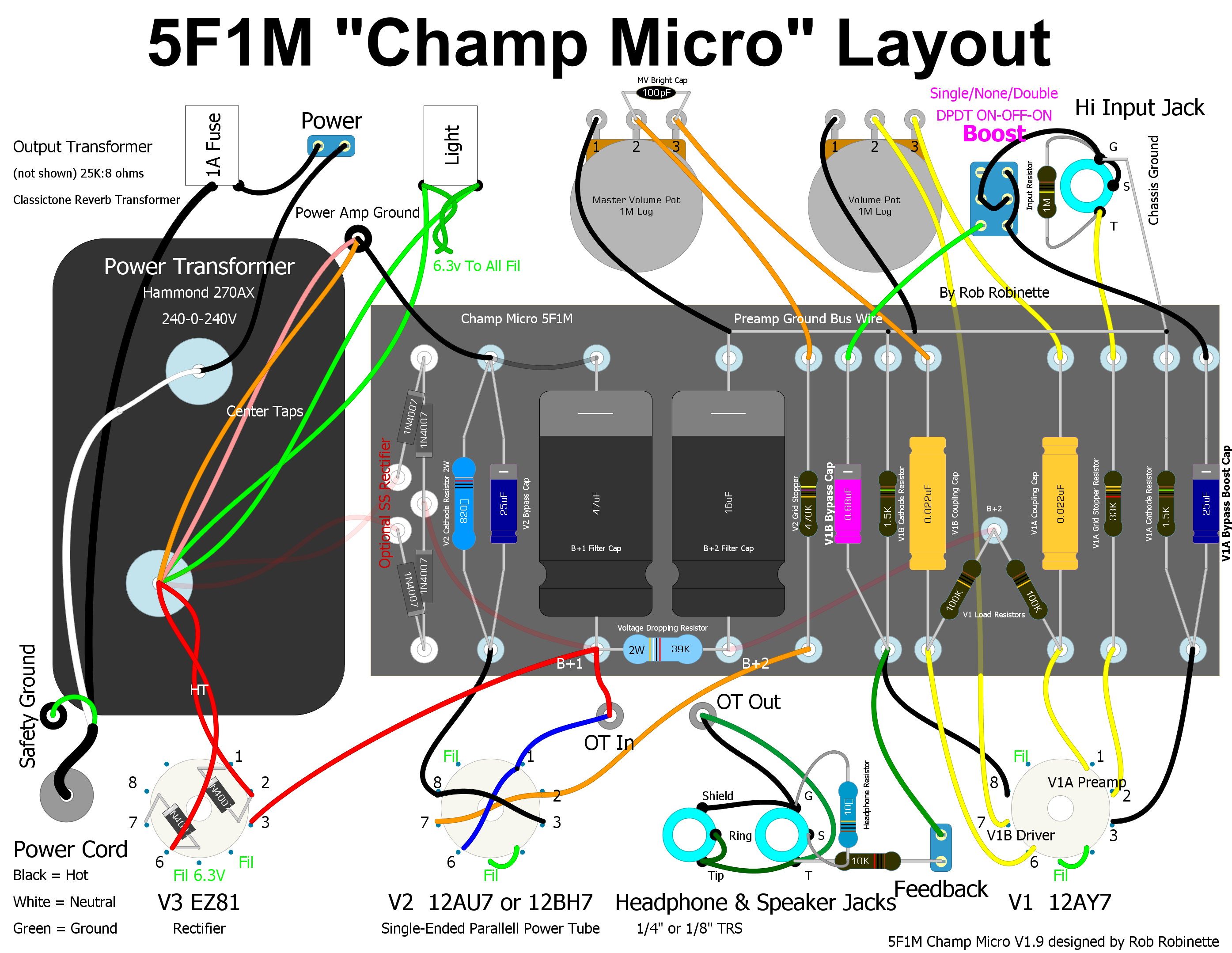
V1B .68uF 25v bypass cap shown in magenta. Its ground is connected to the Boost switch.
How the Champ Micro Works
For a non-technical primer on how guitar tube amplifiers work see my How Tube Amps Work web page. If you have trouble understanding this section I suggest you go back and read this primer.
5F1-M Champ Micro Signal Flow
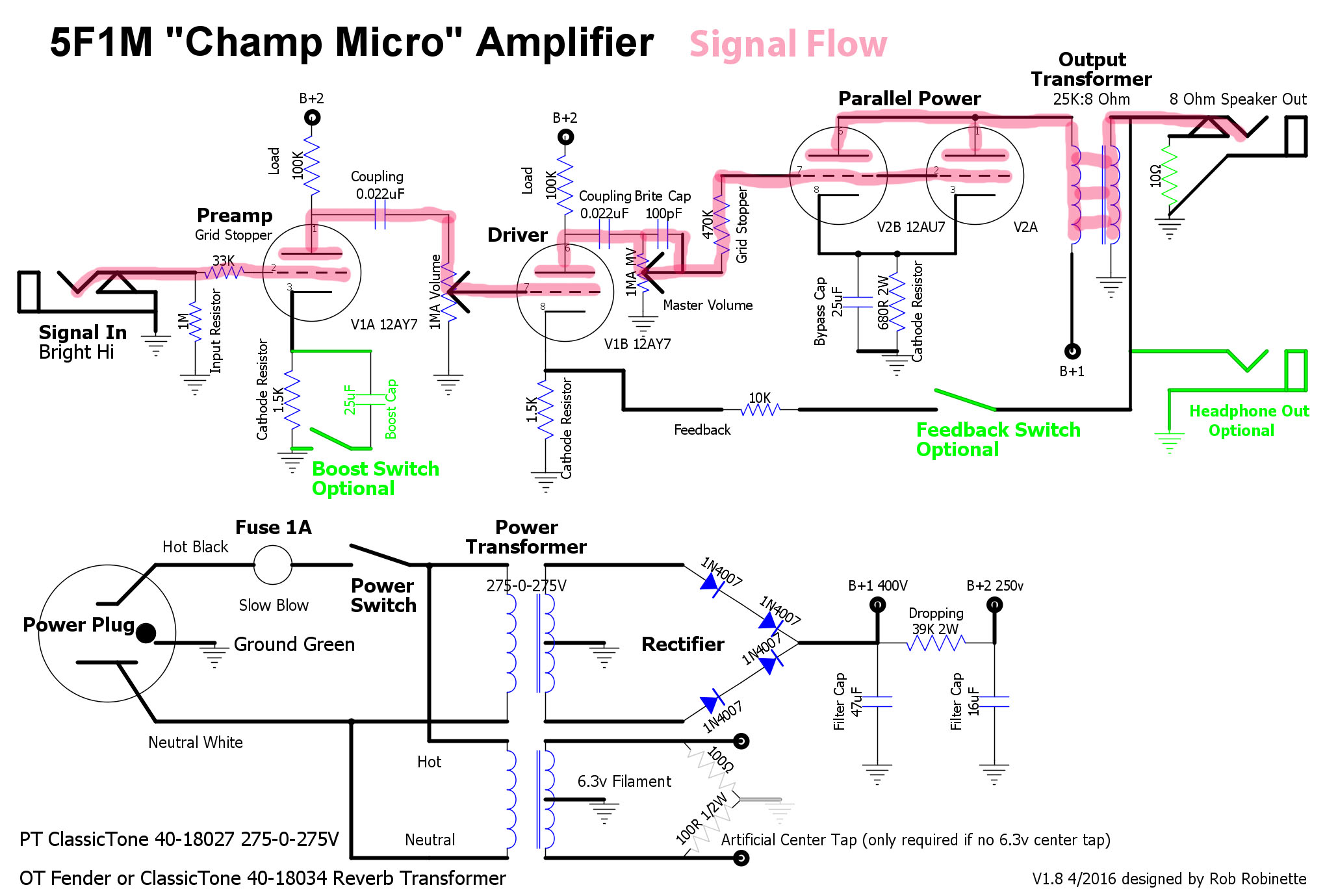
The low voltage alternating current (AC) audio signal from the guitar's pickup coils enters the Deluxe Micro at the Input Jack. Typical signal level from the guitar pickup coils is about 0.1 volt rms but can vary greatly due to the number of pickups, their design and of course how and what is played on the guitar.
The first component the guitar signal encounters is the 1 megaohm impedance bridging Input Resistor. Impedance bridging just means the guitar's and amp's impedance match up correctly for optimum voltage signal transfer (low impedance guitar, high impedance amp). The Input Resistor also functions as the grid leak resistor for tube amplifier stage V1A (valve 1, first half of the tube). A grid leak resistor 'leaks' off unwanted DC (direct current) voltage on the tube's control grid to keep the grid at 0 volts DC. The Control Grid needs to stay at 0 volts to keep the tube bias correct.
After the Input Resistor the signal encounters a 33 kilo ohm Grid Stopper resistor. The Grid Stopper filters out audio signals above human hearing which helps stabilize the amplifier and prevent it from oscillating. After the Grid Stopper the signal hits Tube V1A's Control Grid, pin 2 in the schematic above (our 12AY7 preamp tube is actually two tubes in one--a twin triode--and V1A means 'Valve 1, first triode). V1A is called a triode because it has three electrodes (control grid, cathode and plate, a tube with a fourth, screen grid electrode is called a tetrode and a pentode has a fifth, suppressor grid electrode).
The Control Grid is the 'valve' or gate that controls the flow of electrons through the tube. The tube's Cathode (pin 3) is heated and boils off electrons that want to flow through the Control Grid to the positively charged Plate (pin1). When the guitar signal hits the Control Grid and goes negative it repels and blocks the free electrons inside the tube (like charges repel, opposite charges attract) and keeps them from flowing through the grid to the Plate. When the Control Grid goes positive it allows electrons to flow freely from Cathode to Plate. This is how the tube amplifies the weak guitar signal. The weak signal on the Control Grid controls a large flow of electrons through the tube.
The amplified signal leaves the tube through the Plate and encounters a Load Resistor and Coupling Capacitor. High voltage DC power used by the tube is brought in through a Load Resistor. The Load Resistor converts the amplification stage from current amplification to voltage amplification. The wire between tube pin 1 (plate) and the Load Resistor carries up to 250 volts DC. This wire carries both the AC audio signal and the high voltage DC power the tube needs. The Coupling Cap blocks the high voltage DC on the Plate but allows the AC guitar signal to pass through to the Bright Cap. The Bright Cap brightens the guitar signal by allowing high frequencies to pass around the Volume Control Potentiometer (pot), which is a variable resistor that bleeds the guitar signal to ground at low volume and lets the signal pass at high volume.
The signal then encounters the Tone Control Pot which functions in combination with the Tone Cap as a filter by bleeding high frequency to ground through the Tone Cap. The signal then enters Tube V1B (valve 1, second triode) for its second stage of amplification. The volume and tone pots also function as the V1B grid leak and grid stopper resistors. The amplified guitar signal exits the tube via the Plate and encounters another Coupling Cap that blocks high voltage DC but allows the AC signal to pass to the Master Volume. The Master Volume controls the signal level that flows through a 470K ohm grid stopper resistor to Tube V2's control grid. The large value 470K grid stopper helps prevent blocking distortion in the power amp.
Tube V2 functions as our power tube and is a 12AU7 twin triode tube but both triodes are tied together in parallel. The two control grids, cathodes and plates are connected together. This final stage of amplification creates a high voltage, low current signal. The amplified guitar signal flows through the Output Transformer which trades voltage for current so the output is low voltage but high current which is what our Speaker needs. Typical Deluxe Micro output is 1 watt into an 8 ohm speaker at 2.8V rms and 350 milliamps. The Speaker's Voice Coil needs high current to create the magnetic field that interacts with the Speaker Magnet to make the voice coil and Speaker Cone move in and out creating the air pressure waves our ears perceive as the sweet sound of electric guitar.
By Rob Robinette
References
RCA Corporation, RCA Receiving Tube Manual, RC30.
Merlin Blencowe, Designing Tube Preamps for Guitar and Bass, 2nd Edition.
Merlin Blencowe, Designing High-Fidelity Tube Preamps
Morgan Jones, Valve Amplifiers, 4th Edition.
Richard Kuehnel, Circuit Analysis of a Legendary Tube Amplifier: The Fender Bassman 5F6-A, 3rd Edition.
Richard Kuehnel, Vacuum Tube Circuit Design: Guitar Amplifier Preamps, 2nd Edition.
Richard Kuehnel, Vacuum Tube Circuit Design: Guitar Amplifier Power Amps
Robert C. Megantz, Design and Construction of Tube Guitar Amplifiers
Neumann & Irving, Guitar Amplifier Overdrive, A Visual Tour It's fairly technical but it's the only book written specifically about guitar amplifier overdrive. It includes many graphs to help make the material easier to understand.
T.E. Rutt, Vacuum Tube Triode Nonlinearity as Part of The Electric Guitar Sound
[ How the 5E3 Deluxe Works ] [ Deluxe Models ] [ DRRI & 68 CDR Mods ] [ Amp Troubleshooting ] [ My 5E3 Build ] [ Spice Analysis ] [ The Trainwreck Pages ] [ Fender Input Jacks ] [ B9A Prototype Boards ]
